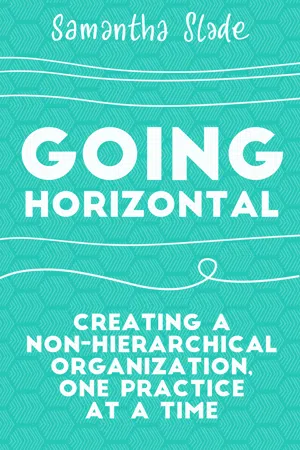
Going Horizontal
Creating a Non-Hierarchical Organization, One Practice at a Time
- 256 pages
- English
- ePUB (mobile friendly)
- Available on iOS & Android
About This Book
Hierarchy in organizations is obsolete. There is a better way: one that increases the engagement of employees and managers alike, reduces micromanaging and other limiting approaches, and promotes organizational and individual success. In this book, self-management expert Samantha Slade presents seven concrete practices to help your organization flatten its existing hierarchy and develop a horizontal organization. The result will be enhanced creativity, greater growth, and a increased employee retention and productivity—and a better bottom line. These days, more than ever, successful organizations must respond quickly and nimbly to change—they need every employee's best thinking. A horizontal organization creates an environment of true collaboration, respect, and openness. It allows everyone more freedom to express unconventional ideas or to work through issues that are getting in the way of organizational goals. And it's a more human way to organize—after all, we function perfectly well in our day-to day lives without someone telling us what to do. But when an organization decides to go horizontal, it can be overwhelming for both managers and employees. Slade offers a practical, proven, incremental method to help organizations of all kinds and sizes ease in to a non-hierarchical model. She includes techniques for using your organization's purpose to stay focused and aligned, developing shared decision-making, creating a mutual feedback culture, nurturing autonomy, holding co-managed meetings, and maintaining an environment of collective learning. Going Horizontal will help organizations become more adaptive, collaborative and innovative, which is vital in today's highly competitive and constantly-evolving world.
Frequently asked questions
Information
INDEX

Table of contents
- Cover
- Title Page
- Copyright Page
- Dedication
- Contents
- Preface
- Introduction
- One: Why Go Horizontal?
- Two: Practicing Is the Path to Mastery
- Three: Autonomy
- Four: Purpose
- Five: Meetings
- Six: Transparency
- Seven: Decision Making
- Eight: Learning and Development
- Nine: Relationships and Conflicts
- Ten: Where Do You Go from Here?
- Appendix: Percolab’s Generative Decision-Making Process
- Notes
- Bibliography
- Acknowledgments
- Index
- About the Author